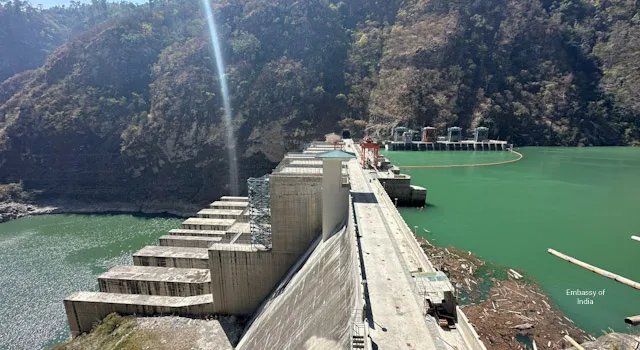The Punatsangchhu-II has become a major highlight in the field of energy cooperation between India and Bhutan. The 1020 MW Punatsangchhu-II Hydroelectric Project has now been fully completed with the successful synchronisation of its last unit, Unit 6 (170 MW), with the national grid. This milestone was officially announced by the Embassy of India in Thimphu, marking a new chapter in Bhutan’s power generation capacity and strengthening Indo-Bhutan energy ties.
Exam Relevance
The Punatsangchhu-II Hydroelectric Project is highly relevant for UPSC and State PSC exams as it connects multiple themes—India-Bhutan bilateral relations (GS-II), renewable energy and regional energy security (GS-III), and current affairs for Prelims. It reflects India’s Act East and neighborhood-first policies, promotes sustainable development through clean hydropower, and strengthens cross-border cooperation. For Prelims, factual details like its location on the Punatsangchhu River (a tributary of Brahmaputra), capacity of 1020 MW, and recent completion in 2025 are important, while for Mains, it can be linked to topics like energy diplomacy, environmental sustainability, and India’s role in South Asia’s development.

Location of Punatsangchhu-II Hydroelectric Project
As per the Punatsangchhu-II, the project is located in the Wangdue Phodrang district of Bhutan, strategically placed on the right bank of the Punatsangchhu River. Its location has been chosen carefully to utilise the river’s natural flow and gradient, ensuring maximum efficiency in clean energy generation.
Capacity of Punatsangchhu-II Hydroelectric Project
The Punatsangchhu-II confirms that the project is a 1 GW run-of-the-river facility with a total installed capacity of 1020 MW. It operates through six Francis turbines, each producing 170 MW. With this completion, Bhutan’s installed power capacity has increased by 40 percent, taking the total beyond 3500 MW. This leap makes Bhutan an even stronger partner in the regional clean energy sector.
Funding and Development
Another significant detail from the Punatsangchhu-II is that the project has been developed under an Inter-Government Agreement (IGA) between the Royal Government of Bhutan and the Government of India. Its funding model includes a 30% grant and 70% loan provided by India at 10% annual interest, repayable in 30 equated semi-annual installments. This unique financial structure reflects India’s strong commitment to Bhutan’s energy security and mutual development.
Key Features of Punatsangchhu-II Hydroelectric Project
The Punatsangchhu-II also highlights the engineering marvels that make this project exceptional:
- Dam Construction: A 91 m-high and 223.8 m-long concrete gravity dam.
- Diversion Tunnel: It is a 877.46 m-long, 12 m-diameter tunnel with a discharge capacity of 1,118 cubic meters per second.
- Cofferdams: Additionally, it includes an upper cofferdam (168.75 m long, 22 m high) and a downstream cofferdam (102.02 m long, 13.5 m tall).
- Sluice Gates: Moreover, there are seven gates, each 8 m-wide and 13.20 m-high.
- Powerhouse: An underground structure 240.7 m-long, 23 m-wide and 51 m-high, housing six advanced turbines operating at a 236 m water head.
Punatsangchhu-II Hydroelectric Project Latest News
The Punatsangchhu-II Counselling Update underlines the latest achievement: the project is now fully operational. With Unit 6 successfully synchronised, Bhutan can not only meet its domestic energy needs more effectively but also expand electricity exports to India. This strengthens both economies while contributing to regional energy security and sustainable development.
Conclusion
The Punatsangchhu-II is more than just a project milestone—it is a symbol of regional cooperation, engineering excellence, and sustainable growth. With its strategic location on the Punatsangchhu River, advanced technical features, and robust capacity, this hydroelectric project has set new benchmarks for energy projects in South Asia. Both India and Bhutan now stand to benefit significantly, making this development a true win-win for the region.
Humanised FAQs on Punatsangchhu-II Counselling Update
It is located in Bhutan, specifically in the Wangdue Phodrang district.
The total installed capacity is 1020 MW, generated through six 170 MW Francis turbines.
According to the Punatsangchhu-II Counselling Update, the Government of India has funded the project with a 30% grant and a 70% loan at 10% interest, repayable over 30 installments.
With its completion, Bhutan’s power generation capacity has risen by 40%, crossing 3500 MW overall. This positions Bhutan as a major clean energy hub in the region.
It enhances India’s energy partnership with Bhutan, ensures clean power imports, and contributes to the shared goal of sustainable development.
Sources









